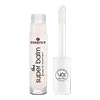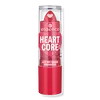What's inside
What's inside
 Key Ingredients
Key Ingredients

 Benefits
Benefits

 Concerns
Concerns

 Ingredients Side-by-side
Ingredients Side-by-side

Polybutene
Diisostearyl Malate
EmollientOctyldodecanol
EmollientSilica
AbrasiveShorea Robusta Resin
TonicGlyceryl Tribehenate/Isostearate/Eicosandioate
EmollientHelianthus Annuus Seed Oil
EmollientButyrospermum Parkii Butter
Skin ConditioningTheobroma Cacao Seed Butter
EmollientTocopheryl Acetate
AntioxidantTocopherol
AntioxidantSodium Hyaluronate
HumectantEthylcellulose
Synthetic Fluorphlogopite
Ethylhexyl Palmitate
EmollientMica
Cosmetic ColorantLupinus Albus Seed Extract
Skin ConditioningTrihydroxystearin
Skin ConditioningGlucomannan
Skin ConditioningAroma
Tin Oxide
AbrasiveCI 77491
Cosmetic ColorantCI 77891
Cosmetic ColorantPolybutene, Diisostearyl Malate, Octyldodecanol, Silica, Shorea Robusta Resin, Glyceryl Tribehenate/Isostearate/Eicosandioate, Helianthus Annuus Seed Oil, Butyrospermum Parkii Butter, Theobroma Cacao Seed Butter, Tocopheryl Acetate, Tocopherol, Sodium Hyaluronate, Ethylcellulose, Synthetic Fluorphlogopite, Ethylhexyl Palmitate, Mica, Lupinus Albus Seed Extract, Trihydroxystearin, Glucomannan, Aroma, Tin Oxide, CI 77491, CI 77891
Bis-Diglyceryl Polyacyladipate-2
EmollientSynthetic Wax
AbrasivePrunus Amygdalus Dulcis Oil
Skin ConditioningPentaerythrityl Tetraisostearate
EmollientPolyisobutene
Ethylhexyl Palmitate
EmollientHydrogenated Castor Oil
EmollientTridecyl Trimellitate
EmollientC12-15 Alkyl Benzoate
AntimicrobialOctyldodecanol
EmollientTrimethyl Pentaphenyl Trisiloxane
EmollientMethyl Hydrogenated Rosinate
PerfumingButyrospermum Parkii Butter
Skin ConditioningSalvia Hispanica Seed Oil
MoisturisingTocopherol
AntioxidantCamellia Oleifera Seed Oil
Skin ConditioningRosa Canina Fruit Oil
EmollientWater
Skin ConditioningCitric Acid
BufferingPhenoxyethanol
PreservativeParfum
MaskingLimonene
PerfumingCI 15850
Cosmetic ColorantCI 77491
Cosmetic ColorantCI 77492
Cosmetic ColorantCI 77499
Cosmetic ColorantCI 77891
Cosmetic ColorantBis-Diglyceryl Polyacyladipate-2, Synthetic Wax, Prunus Amygdalus Dulcis Oil, Pentaerythrityl Tetraisostearate, Polyisobutene, Ethylhexyl Palmitate, Hydrogenated Castor Oil, Tridecyl Trimellitate, C12-15 Alkyl Benzoate, Octyldodecanol, Trimethyl Pentaphenyl Trisiloxane, Methyl Hydrogenated Rosinate, Butyrospermum Parkii Butter, Salvia Hispanica Seed Oil, Tocopherol, Camellia Oleifera Seed Oil, Rosa Canina Fruit Oil, Water, Citric Acid, Phenoxyethanol, Parfum, Limonene, CI 15850, CI 77491, CI 77492, CI 77499, CI 77891
 Reviews
Reviews

Ingredients Explained
These ingredients are found in both products.
Ingredients higher up in an ingredient list are typically present in a larger amount.
This ingredient is also known as shea butter. It is an effective skin hydrator and emollient.
Emollients help soothe and soften your skin. It does this by creating a protective film on your skin. This barrier helps trap moisture and keeps your skin hydrated. Emollients may be effective at treating dry or itchy skin.
Shea butter is rich in antioxidants. Antioxidants help fight free-radicals, or molecules that may harm the body. It is also full of fatty acids including stearic acid and linoleic acid. These acids help replenish the skin and keep skin moisturized.
While Shea Butter has an SPF rating of about 3-4, it is not a sunscreen replacement.
Shea butter may not be fungal acne safe. We recommend speaking with a professional if you have any concerns.
Learn more about Butyrospermum Parkii ButterCi 77491 is also hydrated iron III oxide. It's sole purpose is to give a red/pink hue to products.
Iron III oxides are classified as inorganic chemicals for coloring.
Synthetically created Ci 77491 is considered safer than those naturally found. This is because the synthetically created version may contain less impurities. Iron oxides are generally non-toxic and non-allergenic.
Learn more about CI 77491Ci 77891 is a white pigment from Titanium dioxide. It is naturally found in minerals such as rutile and ilmenite.
It's main function is to add a white color to cosmetics. It can also be mixed with other colors to create different shades.
Ci 77891 is commonly found in sunscreens due to its ability to block UV rays.
Learn more about CI 77891Ethylhexyl Palmitate, also known as octyl palmitate, is created from 2-ethylhexyl alcohol and palmitic acid. It is a fatty acid ester.
The fatty acid content of Ethylhexyl Palmitate makes it an emollient. Emollients help soften and hydrate your skin by trapping moisture within.
Ethylhexyl Palmitate is also used to help improve the texture of cosmetics. It helps other ingredient dissolve in products and help disperse ingredients more evenly.
You'll likely find this ingredient in sunscreen, as it is often used to mix UV-blocking ingredients such as avobenzone and ethylhexyl triazone.
It can also help stabilize the fragrances in a product as a fragrance fixative.
Ethylhexyl Palmitate can be used to substitute mineral oil.
Due to its high fatty acid content, it may not be fungal-acne safe.
Learn more about Ethylhexyl PalmitateOctyldodecanol is a fatty alcohol. It is primarily used to enhance the texture of products.
As an emulsifier, Octyldodecanol helps prevent the oils and waters from separating. It also prevents ingredients from creating foam when shaken.
Octyldodecanol is created by reducing fatty acid to an alcohol.
Due to its high molecular weight, it does not get absorbed into the skin.
Learn more about OctyldodecanolTocopherol (also known as Vitamin E) is a common antioxidant used to help protect the skin from free-radicals and strengthen the skin barrier. It's also fat soluble - this means our skin is great at absorbing it.
Vitamin E also helps keep your natural skin lipids healthy. Your lipid skin barrier naturally consists of lipids, ceramides, and fatty acids. Vitamin E offers extra protection for your skin’s lipid barrier, keeping your skin healthy and nourished.
Another benefit is a bit of UV protection. Vitamin E helps reduce the damage caused by UVB rays. (It should not replace your sunscreen). Combining it with Vitamin C can decrease sunburned cells and hyperpigmentation after UV exposure.
You might have noticed Vitamin E + C often paired together. This is because it is great at stabilizing Vitamin C. Using the two together helps increase the effectiveness of both ingredients.
There are often claims that Vitamin E can reduce/prevent scarring, but these claims haven't been confirmed by scientific research.
Learn more about Tocopherol